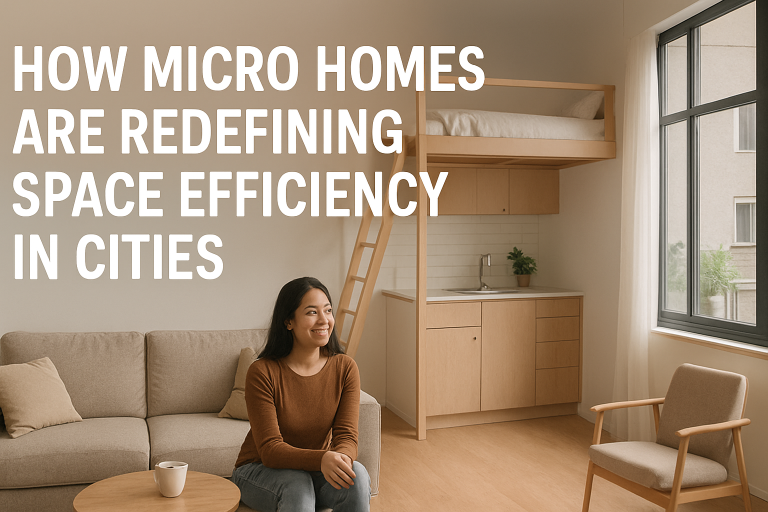How Micro Homes Are Redefining Space Efficiency in Cities
The old “bigger is better” mentality is giving way to “smarter is better” in the densest metropolises in the globe. Presenting the micro home: small, well-designed homes that perfectly balance the essentials. Micro houses are more than just tiny flats; they rethink furniture, light, circulation, and storage to make every square inch of space work hard. Microliving is unlocking previously closed doors for buyers on a tight budget who nevertheless desire a prominent place on the map.

What Does a Micro Home Mean?
Although city-specific standards differ, micro houses are generally between 200 and 500 square feet in size. Their aim makes up for their lack of bulk. Modularity, daylighting, and vertical volume are given top priority by designers. Sleeping lofts and ceiling-mounted storage are made possible by high ceilings. Light is enhanced by large windows and mirrored surfaces. Dead corners are transformed into functional nooks by built-in cabinets. Simplifying is the aim, not squeezing.
Designs That Give the Appearance of Space in Small Spaces
A few tried-and-true moves are included in the tiny house playbook. Swing clearance is maintained via pocket doors. Convertible sofas and wall beds free up floor space during the day. Dining tables with drop leaves can be used as work stations. Undercounter refrigerators, slimline dishwashers, and induction hobs are all used in kitchens. Mirrored cabinets and bathroom niches absorb debris. A single accent piece, such as a chair, rug, or artwork, offers personality without creating visual disturbance, while a neutral foundation colour maintains peace.
Why and Who Purchases Micro?
Micro homes appeal to students, young professionals, single people, and frequent travellers due to their location and flexibility. A simpler, lock-and-leave lifestyle close to transport and medical facilities also appeals to empty nesters. Micro apartments in rental buildings are preferred by landlords because they lower vacancy risk and widen the demand funnel. The ability to provide excellent address value at reasonable ticket sizes is valued by developers.
Typical Issues—and Workable Solutions
Storage and entertainment are two common concerns. Toe kick storage in kitchens, bed platforms with drawers, and full-height wardrobes are the first steps in the storage solution. Fold-out tables, balcony bars, and building-level clubhouses are ways to host parties that a studio cannot. During a tour, enquire about wall assembly and door seals; sound insulation is important in small spaces. It can also relieve pressure on the living area if the building has shared work pods.
A Viewpoint on Investments
From the perspective of an investor, microhomes in walkable areas can yield strong absorption and a healthy rent per square foot. Resilient design, dependable building services, and easy access to daily necessities within a five-minute walk are the keys to resilience. Keep an eye on association dues; while the amenities are excellent, they need to be properly sized and maintained to keep homeowners’ monthly expenses balanced.
Microliving as an Eco-Friendly Option
In general, smaller dwellings require less energy for hot water, lighting, and cooling. Micro living can drastically lower a household’s carbon footprint when combined with minimal volatile organic compounds (VOCs), natural cross ventilation, and energy-efficient equipment. Developers improve sustainability and long-term operational stability by incorporating rainwater collection and rooftop solar for common areas.
The Bottom Line
Clarity—knowing what you really need and skilfully building your home to meet that need—is what micro homes are all about, not compromise. With the correct setting and construction, a microhome may transform your neighbourhood into your living room, feeling freeing rather than confining.
Get in touch with Upgrade Realty
Are you considering a small house close to a big commercial district or a new metro station? For all of your real estate requirements, get in touch with Upgrade Realty. Whether you’re buying to live in or invest in, we’ll help you choose the best planned micro units, assess floor designs for flexibility and storage, and negotiate the best price.
